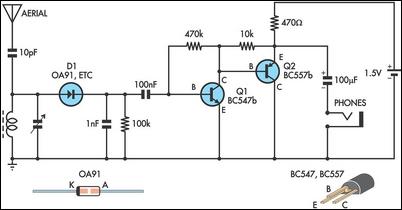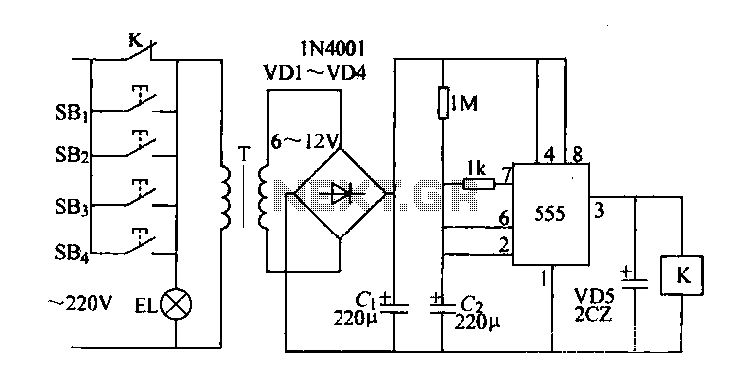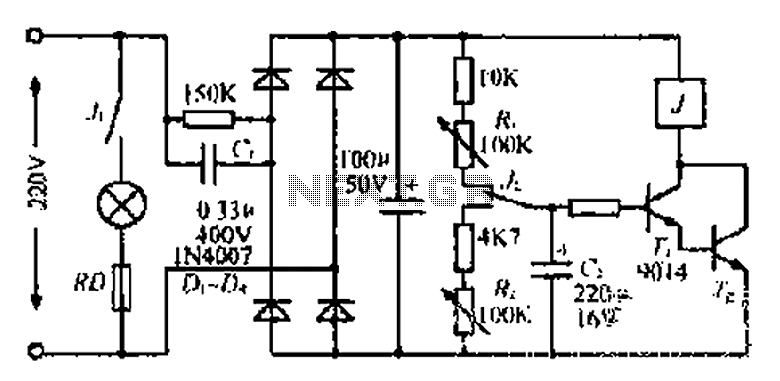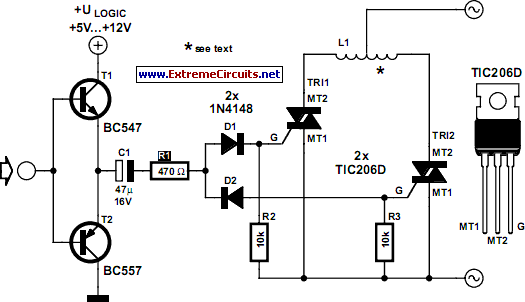
A regenerative SW receiver with automatic regeneration control
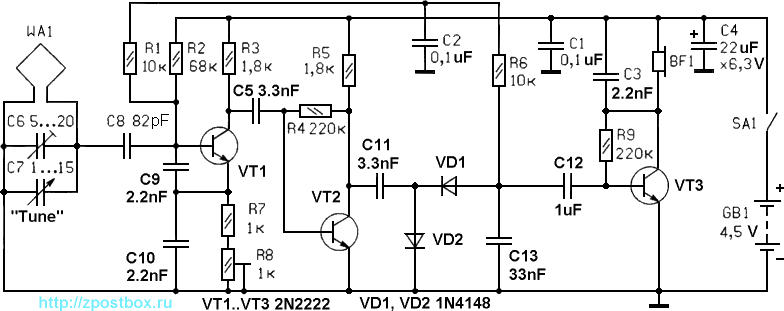
This is a tuned radio frequency receiver designed for shortwave frequencies, specifically in the 25-meter band (11.7 to 12.1 MHz). It serves as an experimental design for further investigations into the autodyne synchronous receiver, as referenced in Polyakov V. T.'s work on autodyne synchronous regenerative receivers published in Radio, 1994, No. 3, page 10. The circuit diagram is illustrated in Figure 1. The input resonant tank consists of the loop antenna WA1 and capacitors C6 (a trimmer capacitor), C7 (a variable capacitor), C8, and C9. This resonant tank circuit exhibits a high quality factor (Q) within the operational frequency range (11.7 to 12.1 MHz), allowing the effective height of the loop antenna to reach several tens of meters, enabling it to receive very weak signals. The sensitivity of this shortwave receiver is primarily limited by the noise of the transistor VT1; thus, employing a low-noise RF transistor in the first stage is recommended. The automatic regeneration control circuit includes a second stage of high-frequency amplification (transistor VT2) and a diode-based detector (C11, VD1, VD2, C13). Resistors R1, R2, and R6 supply bias current to diodes VD1, VD2, and transistor VT1. The output from the detector generates a DC signal that regulates the regeneration of the regenerative stage, while the AC component is routed through capacitor C12 to a single-stage audio amplifier based on transistor VT3. Headphones BF1 serve as the load for this audio amplifier, with an impedance ranging from 1600 to 3200 ohms. The audio amplifier delivers approximately 1 milliwatt of output power. Resistor R4 provides feedback biasing for transistor VT2, while resistor R9 does the same for transistor VT3. Adjust resistor R4 to ensure the voltage across the collector of transistor VT2 is half of the supply voltage. The loop antenna's coil, WA1, has no frame and measures 200 mm in diameter, consisting of two turns of 1.5 mm (AWG 15) copper wire with a winding step of 10 mm. To enhance the rigidity of the loop antenna, the turns can be secured with pieces of dielectric material. Although a ferrite rod can be used to construct the antenna, it will perform significantly worse. The variable capacitor C7 can accommodate larger capacitances, such as 4 to 200 pF, but requires a smaller ceramic capacitor (15 to 25 pF) in series with C7. A varicap could be used for tuning, but it would lower the quality factor Q of the resonant tank circuit and necessitate an additional voltage source of 15 to 25 V. The regenerative stage should be set at the brink of oscillation by adjusting the values of capacitor C10 and the trimming potentiometer R8. This potentiometer must be of high quality; otherwise, its noise may interfere with the receiver's performance. If a high-quality potentiometer is unavailable, it can be replaced with a resistor of equivalent value. The trimmer capacitor C6 is used to fine-tune the frequency band of the receiver. Two limitations of this regenerative receiver include the dependency of the regenerative stage tuning on the supply voltage and a decrease in quality factor when a large object is nearby the loop antenna. The reception quality of this radio receiver surpasses that of a superheterodyne receiver due to its narrow bandwidth, the directional properties of the loop antenna, and the complete absence of image frequency interference. However, these advantages become negligible in the presence of strong radio signals within the operational frequency range.
The tuned radio frequency (TRF) receiver circuit is designed to operate optimally within the 25-meter shortwave band, utilizing a resonant tank circuit that incorporates a loop antenna and several capacitors. The loop antenna, constructed with copper wire, is critical for achieving high sensitivity and selectivity, allowing the receiver to capture weak signals effectively. The choice of components, including low-noise RF transistors and precision capacitors, is essential for minimizing noise and maximizing the quality factor (Q) of the resonant circuit.
The automatic regeneration control circuit is a key feature, enhancing the receiver's ability to maintain stable operation while amplifying incoming signals. The use of a diode detector facilitates the demodulation of the received signals, converting them into a usable audio frequency for headphones. The audio amplifier stage is designed to provide sufficient power to drive the headphones, ensuring clear audio output.
The construction of the loop antenna is particularly important, as its dimensions and winding characteristics directly influence the receiver's performance. The design allows for adjustments in capacitance to optimize tuning, and the inclusion of a trimmer capacitor provides fine-tuning capabilities. However, the design does have limitations, such as sensitivity to nearby objects and supply voltage variations, which can affect the regenerative stage's performance.
Overall, this TRF receiver design offers a robust platform for shortwave radio experimentation, with opportunities for further enhancements and modifications to improve performance and adaptability in various operating conditions.This is the tuned radio frequency receiver for shortwave (25 meter band, 11. 7. 12. 1 MHz). It was created as experimental design for further experiments with the autodyne synchronous receiver (see Polyakov V. T. Autodyne synchronous regenerative receiver. - Radio, 1994, N 3, page. 10. ). The circuit diagram is shown in Figure 1. The input resonant t ank composed of the loop antenna WA1 and capacitors C6 (the trimmer capacitor), C7 (the variable capacitor), C8 and C9. The resonant tank circuit has very high quality factor Q within the working band (11. 7. 12. 1 MHz), so the effective height of the loop antenna can be up to several tens of meters. An antenna with this parameters can receive very weak signals. The sensitivity of this shortwave receiver is limited by the noise of the transistor VT1, so it would be better to use in the first stage a low-noise RF transistor.
The automatic regeneration control circuit includes the second stage of HF amplifier (the transistor VT2) and the diode based detector (C11, VD1, VD2, C13). The resistors R1, R2 and R6 provide a bias current for diodes VD1, VD2 and for the transistor VT1. From the output of the detector the DC signal corrects the regeneration of the regenerative stage, the AC component of signal goes through the capacitor C12 to the one-stage audio amplifier based on the transistor VT3.
The headphones BF1 is the load of this audio amplifier. The resistance of the headphones is about 1600. 3200 ohms. The output power of the audio amplifier is about 1 milliwatt. The resistor R4 provides a feedback biasing for the transistor VT2, and the resistor R9 does the same for the transistor VT3. Match the resistor R4 to get the voltage across the collector of the transistor VT2 equals to half of the supply voltage.
The coil of the loop antenna WA1 is frameless with a diameter of 200 mm, it consists of 2 turns of copper wire 1. 5 mm (AWG 15), the step of the winding is 10 mm. To make the loop antenna rigid, we can fix the turns with each other with pieces of dielectric material.
The antenna can be made out of a ferrite rod, but it would work much worse. The variable capacitor C7 can be used with larger capacitance, for example, 4. 200 pF, but it requires a small ceramic capacitor 15. 25 pF connected in series with C7. A varicap can be used for tuning, but it will reduce the quality factor Q of the resonant tank circuit, and the varicap will require an additional voltage source of 15. 25 V. Setup the regenerative stage on the edge of oscillation by matching value of the capacitor C10 and by adjusting the trimming potentiometer R8.
This potentiometer should be high quality, else its noise will interfere with the receiver. If you haven`t a high quality potentiometer, you can replace it with a resistor (match its value). Use the trimmer capacitor C6 to adjust the frequency band of the receiver. There are two shortages in this regenerative receiver - the tuning of the regenerative stage is depends on the supply voltage, and if there is a massive object in vicinity of the loop antenna, its quality factor goes down. The reception quality of this radio receiver is better than a superheterodyne radio receiver because of the narrow band, the directional properties of the loop antenna, and total absence of an image frequency interference.
But this advantages are useless when there is a powerful radio signal in the working frequency range. 🔗 External reference
The tuned radio frequency (TRF) receiver circuit is designed to operate optimally within the 25-meter shortwave band, utilizing a resonant tank circuit that incorporates a loop antenna and several capacitors. The loop antenna, constructed with copper wire, is critical for achieving high sensitivity and selectivity, allowing the receiver to capture weak signals effectively. The choice of components, including low-noise RF transistors and precision capacitors, is essential for minimizing noise and maximizing the quality factor (Q) of the resonant circuit.
The automatic regeneration control circuit is a key feature, enhancing the receiver's ability to maintain stable operation while amplifying incoming signals. The use of a diode detector facilitates the demodulation of the received signals, converting them into a usable audio frequency for headphones. The audio amplifier stage is designed to provide sufficient power to drive the headphones, ensuring clear audio output.
The construction of the loop antenna is particularly important, as its dimensions and winding characteristics directly influence the receiver's performance. The design allows for adjustments in capacitance to optimize tuning, and the inclusion of a trimmer capacitor provides fine-tuning capabilities. However, the design does have limitations, such as sensitivity to nearby objects and supply voltage variations, which can affect the regenerative stage's performance.
Overall, this TRF receiver design offers a robust platform for shortwave radio experimentation, with opportunities for further enhancements and modifications to improve performance and adaptability in various operating conditions.This is the tuned radio frequency receiver for shortwave (25 meter band, 11. 7. 12. 1 MHz). It was created as experimental design for further experiments with the autodyne synchronous receiver (see Polyakov V. T. Autodyne synchronous regenerative receiver. - Radio, 1994, N 3, page. 10. ). The circuit diagram is shown in Figure 1. The input resonant t ank composed of the loop antenna WA1 and capacitors C6 (the trimmer capacitor), C7 (the variable capacitor), C8 and C9. The resonant tank circuit has very high quality factor Q within the working band (11. 7. 12. 1 MHz), so the effective height of the loop antenna can be up to several tens of meters. An antenna with this parameters can receive very weak signals. The sensitivity of this shortwave receiver is limited by the noise of the transistor VT1, so it would be better to use in the first stage a low-noise RF transistor.
The automatic regeneration control circuit includes the second stage of HF amplifier (the transistor VT2) and the diode based detector (C11, VD1, VD2, C13). The resistors R1, R2 and R6 provide a bias current for diodes VD1, VD2 and for the transistor VT1. From the output of the detector the DC signal corrects the regeneration of the regenerative stage, the AC component of signal goes through the capacitor C12 to the one-stage audio amplifier based on the transistor VT3.
The headphones BF1 is the load of this audio amplifier. The resistance of the headphones is about 1600. 3200 ohms. The output power of the audio amplifier is about 1 milliwatt. The resistor R4 provides a feedback biasing for the transistor VT2, and the resistor R9 does the same for the transistor VT3. Match the resistor R4 to get the voltage across the collector of the transistor VT2 equals to half of the supply voltage.
The coil of the loop antenna WA1 is frameless with a diameter of 200 mm, it consists of 2 turns of copper wire 1. 5 mm (AWG 15), the step of the winding is 10 mm. To make the loop antenna rigid, we can fix the turns with each other with pieces of dielectric material.
The antenna can be made out of a ferrite rod, but it would work much worse. The variable capacitor C7 can be used with larger capacitance, for example, 4. 200 pF, but it requires a small ceramic capacitor 15. 25 pF connected in series with C7. A varicap can be used for tuning, but it will reduce the quality factor Q of the resonant tank circuit, and the varicap will require an additional voltage source of 15. 25 V. Setup the regenerative stage on the edge of oscillation by matching value of the capacitor C10 and by adjusting the trimming potentiometer R8.
This potentiometer should be high quality, else its noise will interfere with the receiver. If you haven`t a high quality potentiometer, you can replace it with a resistor (match its value). Use the trimmer capacitor C6 to adjust the frequency band of the receiver. There are two shortages in this regenerative receiver - the tuning of the regenerative stage is depends on the supply voltage, and if there is a massive object in vicinity of the loop antenna, its quality factor goes down. The reception quality of this radio receiver is better than a superheterodyne radio receiver because of the narrow band, the directional properties of the loop antenna, and total absence of an image frequency interference.
But this advantages are useless when there is a powerful radio signal in the working frequency range. 🔗 External reference
